2023.08.04.53
Files > Volume 8 > Vol 8 no 4 2023
Ahmed Aldhamin1*
1 College of Science, University of Baghdad, Baghdad, Iraq.
Correspondence: [email protected].
Available from. http://dx.doi.org/10.21931/RB/2023.08.04.53
ABSTRACT
Safe drinking water is essential for the present and future generations' health. This study aims to assess drinking water quality in Baghdad's Al-Rusafa neighborhood. Water samples were taken from 32 neighborhoods on this side. The quality of the examined potable water samples differed depending on the water source. This investigation's pH, chlorine, EC, TDS, TSS, Cd, and Pb levels were below acceptable ranges. TDS levels in Al-Mada'in are more significant than acceptable (>600ppm) water levels. Bacteria have polluted six communities (Shigella, Salmonella, Escherichia coli, and Klebsiella). Bacterial quality of drinking water and gram-negative bacteria resistant to chlorine in Baghdad's municipal water supply. Regarding pH, the water quality, EC, TDS, TSS, Pb, and Cd of Al-Rusafa neighborhoods were within the recommended limits of WHO and the Iraqi drinking water standards.
Keywords: Safe drinking water; contaminated bacteria; Baghdad city; healthcare; pH; Temperature.
INTRODUCTION
Water is necessary for all forms of life to survive. Globally, there are growing water shortages, and the strain on current water resources is increasing due to rising demands in various sectors, including drinking, bathing, showering, agriculture, industrial operations, etc. In general, water quality is just as essential as water supply. As a result, water quality is a critical criterion for assessing environmental changes linked to social and economic development 1. Consumption of low-quality drinking water poses several health hazards to the population, ultimately driving up healthcare costs 2.
Drinking water polluted with heavy metals, such as Cadmium and lead, is becoming a significant health problem for the general population and providers. On the other hand, the intake of polluted drinking water is the most common source of quantifiable human exposure to heavy metals. Cardiovascular problems, neurological damage, renal injuries, and the risk of cancer and diabetes are all possible side effects. Generating reactive oxygen species, which causes oxidative damage and harmful health consequences, is implicated in heavy metal-induced toxicity. As a result, using heavy metal-contaminated water causes significant rates of sickness and mortality worldwide 3.
The incidence of bacteria in the end product is called the bacteriological quality of drinking water. Contaminated water and hygiene are associated with illnesses including cholera, diarrhea, dysentery, hepatitis A, typhoid, and polio transmission. Individuals are exposed to preventable health hazards due to insufficient or poorly managed water and sanitation facilities 2.
Because of its increased oxidizing potential, low cost, ease of operation, and efficacy in improving drinking water quality, chlorination is one of the most extensively used disinfection methods. The kind and concentration (or intensity) of the disinfectant, the type and concentration of microorganisms, and the physicochemical qualities of the source water all play a part in the implementation. The disinfection procedure should strike a balance between killing or inactivating a wide range of pathogens, the ability to retain a residual, and the development of toxic disinfection by-products 4.
Based on these findings, the current study attempted to assess the drinking water quality in Al-Rusfa by 1) evaluating physical and chemical parameters such as pH, TDS, TSS, EC, and chlorination, and 2) Cadmium lead concentrations. 3) Contaminants caused by microorganisms.
MATERIALS AND METHODS
Region of the study
Baghdad is the capital of Iraq, divided into two sides: Al-Rusafa and Al-Karkh, located in the eastern and western Tigris Rivers, respectively. This work was performed in the Al-Rusafa side, with 32 prominent residential neighborhoods. As shown in Figure 1
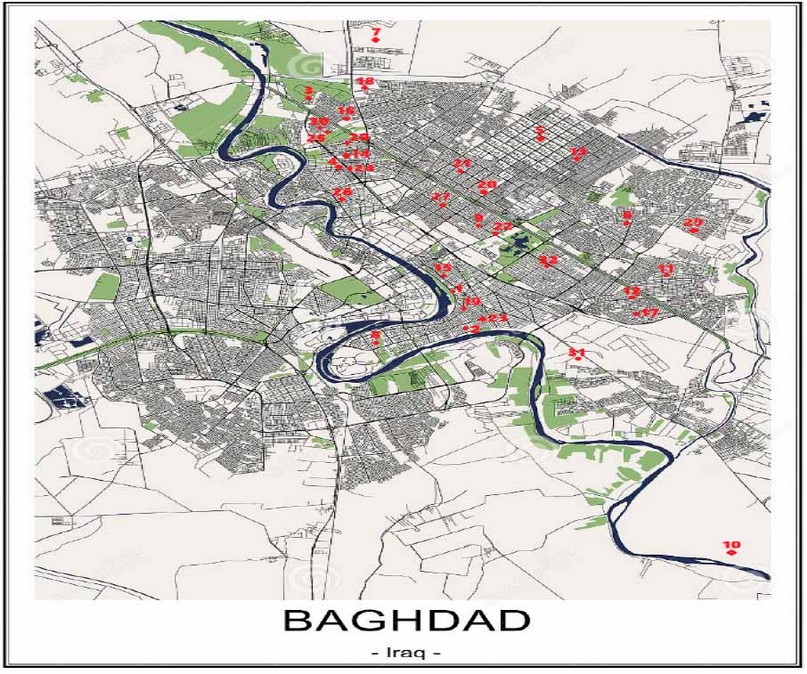
Figure 1. A map of Baghdad city showing the study areas on the Al-Rusafa side.
Water sampling
The samples of drinking water were collected from 32 neighbourhoods (Abu Nawas 1, Al-Arassat 2, Al-Basatine 3, Al-Camp 4, Al-Chwader 5, Al-Fadiliyah 6, Al-Husseiniya 7, Al-Jadiriyah 8, Al-Jwadane 9, Al-Mada'in 10, Al-Mu'almeen 11, Al-Naeria 12, Al-Obaidi 13, Al-Qahira 14, Al-Sadoon 15, Al-Shaab 16, Baghdad Aljadeeda 17, Bob Al-Sham 18, Inner Karrada 19, Jameela 20, MadinatAssadar 21, Martyrs' Gate 22, Outer Karrada 23, RaghbaKhatun 24, SabeAbkar 25, Shari Almaghrib 26, Shari Falastine 27, Slakhe 28, Swedan 29, Tunis 30, Zafaraniya 31, and Zayouna 32) in Al-Rusafa side /Baghdad province from August 2021 to December 2021 for all bacteriological, physical, chemical examinations. The samples were collected from the distribution system tap. Instead of a tap serviced by a reservoir or storage tank, a tap that provides water from a service pipe directly linked to the main pipe was chosen. All attachments were removed, and the cold-water tap was opened entirely for 2-3 minutes to clean the support line or long enough to flow out the effluent. Water was collected in sterile bottles (for bacteriological testing, 250 mL glass jars with metallic screw closures and rubbers were used, pre-sterilized in an oven at 160°C for 2 hours), sealed firmly, and delivered to the laboratories within 2-3 hours.
pH and Temperature
These parameters were measured using a Waterproof Portable pH/Temperature Meter(Hanna instrument, Romania).
Electrical conductivity and total suspended solids
These parameters were measured using Portable EC/TDS/Salinity meters (Hanna, Romania).
Total Dissolved Solids
The filtration technique used a membrane filter (LABSCO, Germany). The filtrate was dried completely in an oven at 103 - 105°C. The TDS was calculated using the following equation:
TDS mg/1= [(A - B)/ filtrated sample volume in L] x 1000 …………… (1)
Where:
A (mg) = weight of dried residue + flask.
B (mg) = weight of flask.
The results were expressed as mg/1.5
Free residual chlorine
It was measured in the field at the exact sample locations from tap water using a field DR-700 colorimeter (Hach) and a manual comparative chromatography using the diethyl phenyl diamine (DPD) titrimetric technique 4500-CI-F. 5. After adding a phosphate buffer, this approach requires adding a DPD indicator solution. When the C12 oxidizes the DPD, it turns red. The results were given in parts per million (ppm).
Cadmium and Lead
Water samples were filtered to remove particulate matter. Cadmium (Cd) and lead (Pb) were estimated by the atomic absorption spectrometer (Perkin Elmer model 5000).6
Detection of bacteria
Water samples were cultured on Blood agar (HiMedia, India) and incubated at 37°C for 24 hrs. After that, the resultant colonies were re-cultured on MacConkey agar (Oxoid, UK) and incubated at 37°C for 24 hrs. VITEC 2 Compact (bioMérieux, France) was employed to identify bacterial isolates. The bacterial count was done using a viable count technique using phosphate-buffered saline as a diluent.7
Statistical analysis
Data were presented in this work as the mean of at least three replicates ± standard deviation. ANOVA one way and the least significant difference with an alpha = 0.05 were used to calculate significance using the SPSS application. A P-value < 0.05 was considered statistically significant.8
RESULTS
As shown in Figure 2, the pH (P < 0.05) varied among study areas, ranging from 7.0 – 7.9 ± 0.16. However, the lowest pH value (7.0) was detected in Inner Karrada, whereas the highest (7.9) was recorded in Al-Huseiniya, Al-Chwader, Slakhe, and Al-Camp.
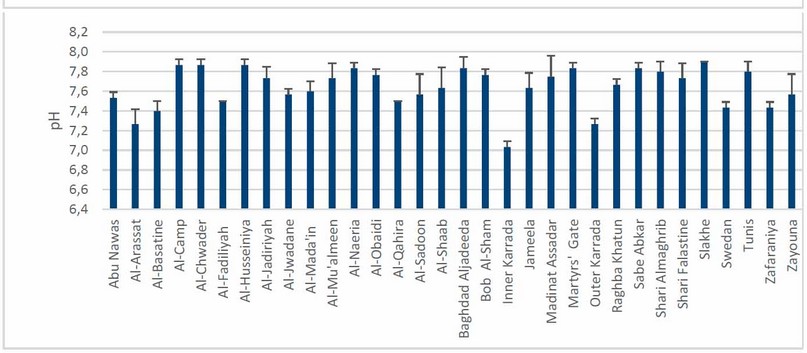
Figure 2. pH values in the tap water of Al-Rusafa side cities. P= 2.68 × 10-22, LSD= 0.16.
Regarding residual chlorine (Cl), it demonstrated a significant (P < 0.05) variation among study areas as it ranged from 0.0 – 3.0 ± 0.36 ppm across all neighborhoods (Figure 3). Nevertheless, the lowest Cl value (0.0) was detected in Al-Jadiriyah, Zayouna, and Al-Shaab, whereas the highest Cl value (3.0) was recorded in Al-Mada'in, Baghdad Aljadeeda and RaghbaKhatun.
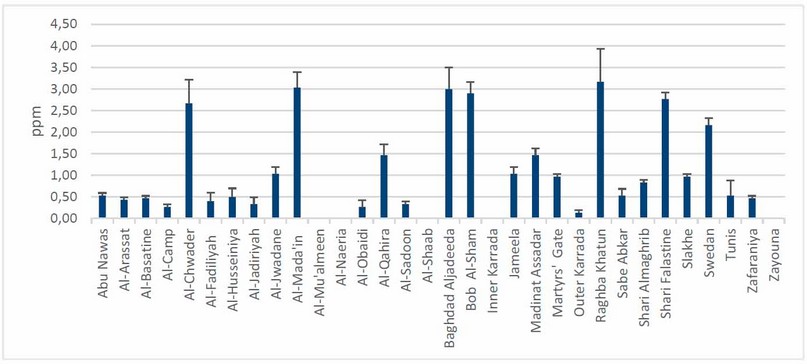
Figure 3. Residual chlorine concentration in the tap water of Al-Rusafa side cities. P= 3.46 × 10-48, LSD= 0.36.
The present work found that the Electrical Conductivity (EC) ranged between 760 - 1360 ± 52.43 µS/cm (Figure 4). However, the highest level (1360 µS/cm) was recorded in Al Mada'in, whereas the lowest level (760 µS/cm) was recorded in Al-Arassat and Outer Karrada.
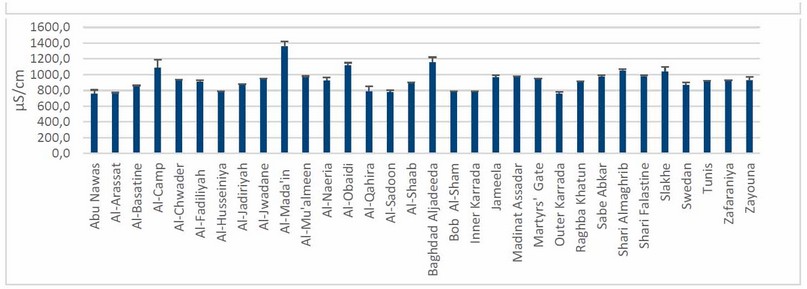
Figure 4. Electrical conductivity values in the tap water of Al-Rusafa side cities. P= 9.35 × 10-43, LSD= 52.43.
The TSS values of all the drinking water samples studied are shown in Figure 5. The highest values of 12, 9, 10, and 12 mg/l were found in water samples from Al-Mada'in, Al-Arassat, and Al-Naeria, respectively. Nonetheless, the lowest values (0 mg/l) in many neighborhoods. However, it is still well below the maximum standard limit.
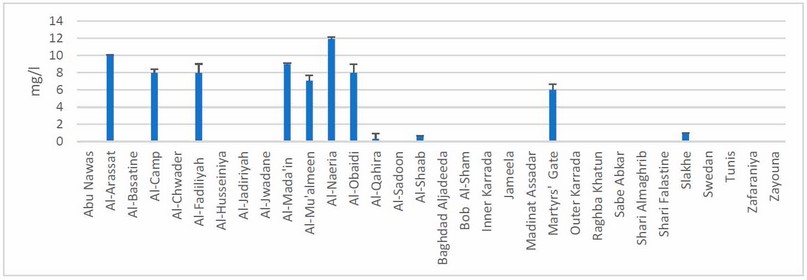
Figure 5. Total suspended solids concentrations in Al-Rusafa side cities tap water. P= 1.43 × 10-80, LSD= 4.72
TDS's highest level (680 mg/1) was recorded in Al-Mada'in, whereas the lowest concentration (380 mg/1) was detected in Abu Nawas (Figure 6).
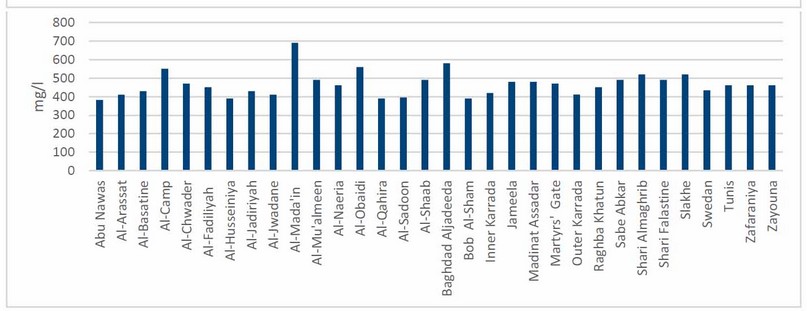
Figure 6. Total dissolved solids concentrations in Al-Rusafa side cities tap water. P= 1 × 10-14, LSD= 66.14.
As shown in Figure 7, The highest concentration of Cd (0.03 ppm) was found in Zayouna, while the lowest one (0.003 ppm) was encountered in many neighborhoods. On the other hand, Pb's highest concentration (0.065,0.067,0.067, and 0.068 ppm) was in Al-Chwader, MadinatAssadar, Al-Fadiliyah, and Al-Obaidi, respectively. The lowest concentration (0.02 ppm) was detected in Slakhe (Figure 8). According to Iraqi specifications, these concentrations were accepted, and Cadmium is a naturally occurring metal in the planet's crust.
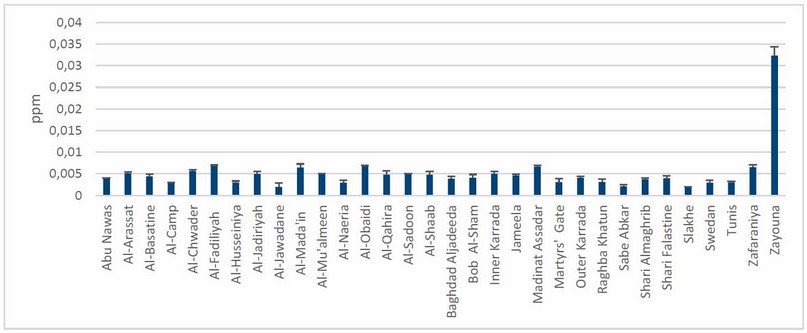
Figure 7. Cadmium concentrations in tap water of Al-Rusafa side cities. P 5.74 × 10-66, LSD= 0.000948.
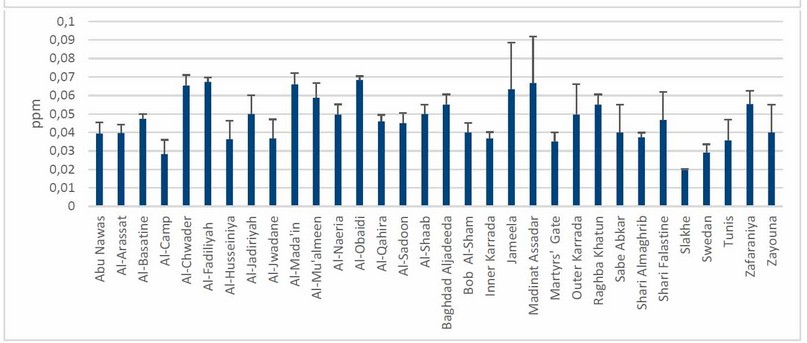
Figure 8. Lead concentrations in the tap water of Al-Rusafa side cities. P 8.67 × 10-11, LSD= 0.015.
According to the microscopic examination and biochemical test, the results showed that the potable water of six neighborhoods on the Al-Rusafa side was contaminated with bacteria (Shigella, Salmonella, E. coli, and Klebsiella)
Due to old pipe projects, they may have been contaminated with sewage or inefficient precipitation and filtration processes. A low concentration of chlorine was added to the water plant. Zayouna and Al-Shaab's chlorine concentration was not detected; therefore, Salmonella's growth and Shigellawere encouraged. Similarly, the growth of Klebsiella, E. coli, and Salmonella was detected in Slakhe, Al-Obaidi, and Inner Karada, which had low concentrations of chlorine—furthermore, a concentration of 3.0 mgl in Mad.
DISCUSSION
The quality of drinking water, its quantity, and consumption management signify population growth. Hence, drinking water quality is vital for human and animal life.
However, according to the Iraqi Criteria and Standards of Water's chemical limitations (6.5-8.5), ICS/13.060.20 number 417/2009, second version, the lowest and highest pH values reported in this study were beyond the allowed ranges of Iraqi freshwater quality criteria.
The most raw water pH of sources lies at 6.5 to 8.5 9. In some areas, however, the water pH can be considerably lower due to organic acids from decaying vegetation or biological activity and dissolved carbon dioxide. Furthermore, additional alum doses precipitate calcium carbonate (CaCO3) to control pipe corrosion. In addition to that, sandstorm effects increase the CaCO3 concentration in Water 10. Also, one of the essential factors influencing water pH was the rainfall during winter. Naturally, the rain is slightly acidic due to air-dissolved carbon dioxide 11. The results of the present study are supported by other local studies 12-14.
The gradual decrease of residual chlorine concentrations from the addition point to the farthest sampling point may be due to the decomposition of chlorine when it reacts with water to hydrochloric acid. This acid is decomposed rapidly into hydrogen and hypochlorite ions 2; due to the loss of water pressure in the pipeline, drinking water is mixed with polluted water from the environment, especially when networking pipes have fractures and cracks 15. According to the Iraqi Criteria and Standards of Water's chemical limits, ICS/13.060.20 number 417/2009, second update, the min and max free residual chlorine values recorded in this study were within the specified range for Iraqi standards for drinking water in some neighborhoods but not in others.
The EC results may be explained by reverse osmosis treatment, removing dissolved particles, turbidity, colloidal debris, and other impurities, resulting in the lowest conductivity value. Similarly, increased mineral concentration in mineral water is predicted, resulting in higher conductivity 16.
Interestingly, most areas developed no TSS. The results varied among neighborhoods due to their filtration systems, which removed suspended particles such as silt, clay, and other inorganic particles 15. The maximum recommended Total Suspended Solids (TSS) limit set by the Iraqi Maximum desired value is 60 mg/l 17.
According to 18, filtration systems help reduce TDS. Nonetheless, the maximum levels recorded in this research were less than 1000 mg/1, below the acceptable parameters of Iraqi drinking water standards, as defined by the Iraqi Standards and Specifications of Water's chemical limitations, ICS/13.060.20 number 417/2009, 2nd update.
Acute exposure to much greater cadmium levels can cause diarrhea, vomiting, fever, lung damage, and muscular soreness, among other things 19. Cadmium concentrations in unpolluted natural waterways are typically below 0.003 parts per million, while the highest allowable Pb value in drinking water was 0.01 per million. Pb in drinking water is usually found in service connections and building plumbing 2. Tetra alkyl lead in gasoline and lead arsenate as fungicides, plasters, paints, home dust, and wastewater may produce Pb pollution in metropolitan areas. The steel industry, batteries, and polymers all utilize Cd. Cadmium in the environment is also heavily influenced by wastewater and fertilizers. Cd is harmful even at low concentrations 20.
As a result, any changes in the number of microorganisms in the pipes can be attributed to flushing, chlorination, or attachment to or release from the biofilm, which may be ineffective since the biofilm protects the bacteria 21.
E. coli was the most common, followed by Citrobacter spp., Shigella spp., Enterobacter spp., Providencia spp., Klebsiella spp., Salmonella spp., Pseudomonas spp., Proteus spp., and Edwardsiella spp. At 0.2 mg/l for a contract duration of 30 minutes, all eight genera of a Gram-negative 21.
Total coliform was identified in those samples below the recommended amounts for free residual chlorine, according to 22-23. The adhesion of microorganisms to surfaces dramatically increased disinfection resistance, according to 24. Other factors that boosted disinfection resistance were biofilm age, bacterial encapsulation, and prior growth circumstances, which raised chlorine resistance by 2- to 10-fold.
Because water treatment facilities cannot eradicate all Coliforms, the effectiveness of drinking water treatment against gram-negative bacterial isolates should be checked regularly 25. Chlorine-resistant microbiological species should be retrieved from chlorinated water distribution systems if they exist 26. As a result, this research was conducted to evaluate drinking water's physicochemical and microbiological quality and investigate chlorine-resistant gram-negative bacteria in Baghdad's municipal drinking water supply.
CONCLUSIONS
The study concluded that the physicochemical and microbiological quality of drinking water in Baghdad is not up to the acceptable standards of Iraqi drinking water. The pH of the water was found to be outside the acceptable range, and the levels of chlorine, TDS, and Cadmium were also higher than the recommended values. The microbiological analysis revealed the presence of coliform bacteria, which can indicate contamination with fecal matter. The researchers also found that the water contained chlorine-resistant gram-negative bacteria. These bacteria can survive the chlorination process used to disinfect drinking water and pose a health risk to the population.v
The water quality in Al-Rusaf neighborhoods' pH, EC, TDS, TSS, Pb, and Cd was within the recommended limits of WHO and the Iraqi drinking water standards. However, E. coli, Klebsiella, Salmonella, and Shigella were detected in six neighborhoods.
Funding: This research received no external funding
Acknowledgments: I want to express my special gratitude to my best friend (Harith Al-Mathkhury).
Conflicts of Interest: The author declares no conflict of interest.
REFERENCES
1. Van Vliet M.T.H.; Jones E.R.; Flörke M., Franssen W. H P.; Hanasaki N.; Wada Y.and Yearsley J.
R. Global water scarcity, including surface water quality and expansions of clean water
technologies. Env Res Let 2021,16. DOI: 10.1088/1748-9326/abbfc3
2. WHO. Drinking water Fact sheet, 2019.
3. Rehman K.; Fatima F.; Waheed I., Akash M. S. H.. Prevalence of exposure of heavy metals and their
Impact on health consequences. J Cell Biochem 2018,119,157-184. DOI: 10.1002/jcb.26234
4. Jalali Milani S.; Nabi Bidhendi G. A Review on the Potential of Common Disinfection Processes
for Removing Virus from Wastewater. Int J Environ Res 2022,16,9.
5. American Public Health Association (APHA) t. AWWAA, and the Water Environment
Federation (WEF) 2540 SOLIDS. Standard Methods For the Examination of Water and
Wastewater. 23 ed: American Public Health Association, 2017.
6. Fu, F., Wang, Q. Removal of heavy metal ions from wastewaters: a review. J. Environ. Manag.
2011. 92, 407–418.
7. Noaman A I, Khalaf R M, Emad GH, Al-Abbasy, Mohammed Th. T. Effect of flaxseed oil dosing on fertility, growth characteristics and some physical, biochemical, and hormonal blood parameters during the early pregnancy of Awassi ewes. Revis Bionatura. 2022;7(4) 5. http://dx.doi.org/10.21931/RB/2022.07.04.5
8. Statistical Analysis System, User's Guide. Statistical. Version 9.6th ed. SAS. Inst. Inc. Cary. NC.
USA.2018.
9. Alaaraji, S.F.T., Mohisen, M.A., Awad, M.M. Assessment serum levels of neopterin, IL-6, IL-1β, hs-CRP, TNF-α and MMP 9 in iraqi rheumatoid arthritis patients (2020) Systematic Reviews in Pharmacy, 11 (12), pp. 88-93.
10. Abdalsamed I.; Amar I.; Sharif A.et al.,. Scale Corrosion of Metallic Materials in Water Systems- A
Review. J Chem Rev 2022,4,67-80. DOI: 10.22034/JCR.2022.326770.1141
11. Al-Atijawi, S. H. .; Almusawy, R. S. . The Effect Of Adding Different Rates Of Mushroom Powder To The Wheat Flour On The Nutritional Value Of Proteins, Sensory And Physical Properties Of Local Bread. JLSAR 2021, 2, 46–53.
12. Awadh S.M. The Atmospheric Pollution of Baghdad City, Iraq. 3rd scientific conference of
College of Science, University of Baghdad 2009;1727-1740.
13. AL-Amier F.H.G. Study the Impact of the wastewater discharged from Al-Karama and Sharq- Dijla
water treatment plants on the water quality of Tigris River. College of Science. Baghdad, Iraq:
University of Baghdad, 2014.
14. Abdul-Kareem A.; Khalil M.; AL-Hadidi K. Chemical composition and salt load in rainwater of
Mosul city-Nineveh governorate. Mesopotamia J Agr 2018,46,279-285.
15. Salah N. Evaluation of Municipal Water Quality and Health Risks of Trihallogen Organic
Compounds in Baghdad College of Science. Baghdad, Iraq: University of Baghdad, 2016.
16. Rahmanian N.; Ali S.H.B.; Homayoonfard M., et al. Analysis of Physiochemical Parameters to
Evaluate the Drinking Water Quality in the State of Perak, Malaysia. J Chem 2015,2015,1-10.
DOI: 10.1155/2015/716125
17. Ibraheem M W, AL Mjbel A A, Abdulwahid A S, Mohammed Th. T. Characterization of the influence of diet on Japanese quail. Revis Bionatura. 2022;7(4) 21. http://dx.doi.org/10.21931/RB/2022.07.04.21.
18. Ali, A. F. .; Mohammed, T. T. .; Al-Bandar, L. K. . The Role Of Optifeed®, Vêo® Premium, And Oleobiotec® In Diets For Improvement Of The Production Performance Of Male Broilers In Heat Stress. JLSAR 2022, 3, 32-36
19. Nordberg G.F. Cadmium and health in the 21st century--historical remarks and trends for the future.
Biometals 2004,17,485-489.
20. A. Mahdii, B., K. Imran, F., J. Sultan, L. The Efficiency Of Microbiology In The Process Of Pesticide Biodegradation. Anbar Journal Of Agricultural Sciences, 2023; 21(1): 105-113. doi: 10.32649/ajas.2023.179720
21. Van Bel N.; Hornstra L.M.; van der Veen A., et al. Efficacy of Flushing and Chlorination in
Removing Microorganisms from a Pilot Drinking Water Distribution System. Water 2019,11.
22. Mahmood, N. A. & Abdulateef, S. M. Determining Some Undesirable Behavioral Traits and Their Impact on the Behavioral Performance of Broiler Chicks. in IOP Conference Series: Earth and Environmental Science .2021,vol. 904
23. Torrance, L., Cowan, G. H., McLean, K., MacFarlane, S., Al-Abedy, A. N., Armstrong, M., ... &
Bryan, G. J. (2020). Natural resistance to Potato virus Y in Solanum tuberosum Group
Phureja. Theoretical and Applied Genetics, 133, 967-980.
24. Gopali J. Study of microbial quality of chlorinated drinking water of Kathmandu. Department of
Microbiology. Nayabazar, Kathmandu: National College, 2008.
25. Bibani, N. M. S., Khidhir, Z. K., Shaker, A. S., Kirkuki, S. M. S. & Abdulateef, S. M. Analyses of mycotoxins in broiler's local and imported feeds. Iraqi J. Vet.2019 Sci. 33
26. Ridgway H.F.; Olson B.H. Chlorine resistance patterns of bacteria from two drinking water
distribution systems. Appl Environ Microbiol 1982,44,972-987. DOI: 10.1128/AEM.44.4.972-987.1982
Received: 26 September 2023 / Accepted: 15 April 2023 / Published:15 December 2023
Citation: Aldhamin, Ahmed, Evaluation of the quality of potable water in Al-Rusafa side, Baghdad, Iraq.
Revis Bionatura 2023;8 (4) 53. http://dx.doi.org/10.21931/RB/2023.08.04.53
Publisher's Note: Bionatura stays neutral concerning jurisdictional claims in published maps and institutional affiliations.
Copyright: © 2023 by the authors. Submitted for possible open-access publication under the terms and conditions of the Creative Commons Attribution (CC BY) license (https://creativecommons.org/licenses/by/4.0/).
